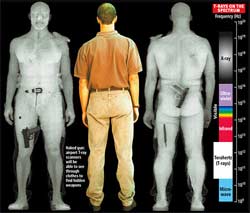
However, THz scanners must usually be very close to the objects they are imaging. Doubts have lingered over whether it is possible to use THz waves to image objects that are far away, because water vapor in air absorbs THz radiation so strongly that most of it never reaches the object to be imaged.
At the upcoming CLEO/QELS meeting in Baltimore, an MIT-Sandia team will demonstrate the first real-time THz imaging system that obtains images from 25 meters away. The technique takes advantage of the fact that there are a few "windows," or frequency ranges, of the terahertz spectrum that do not absorb water very strongly.
The MIT-Sandia group designed a special, semiconductor-based device known as a "quantum cascade laser" that delivers light in one of these windows (specifically, around 4.9 THz). They shine this light through a thin target with low water content (for example, a dried seed pod), and a detector on the other side of the sample records an image.
A cryorefrigerator maintains the laser at a temperature of 30 Kelvin, where it produces 17 milliwatts of power (as opposed to the microwatts of power typical of pulsed terahertz sources) in order to provide enough terahertz radiation to obtain a decent image. Increasing the power of the lasers and sensitivity of the detectors can potentially enable imaging of thicker objects or imaging of the reflected light, which would be more practical for security applications.

In addition, the development of high-operating-temperature quantum cascade lasers, which operate without the use of cryogenic materials, may also increase the availability of this approach. In the closer term, however, this approach may enable sensing of chemical residues or contaminants in the air.

